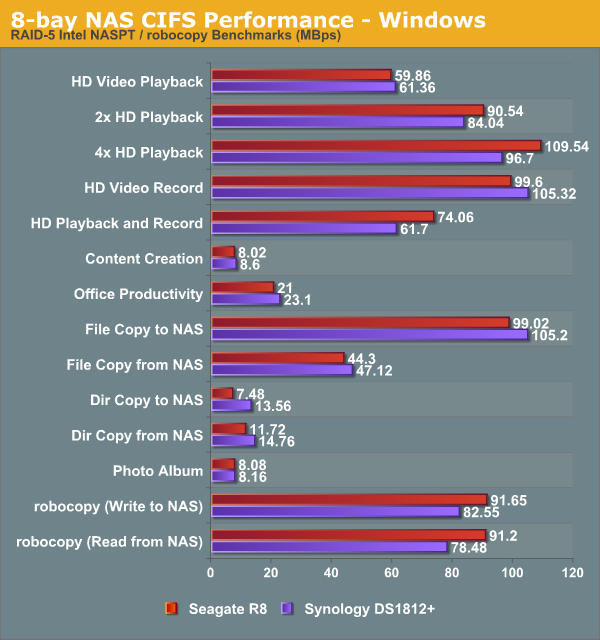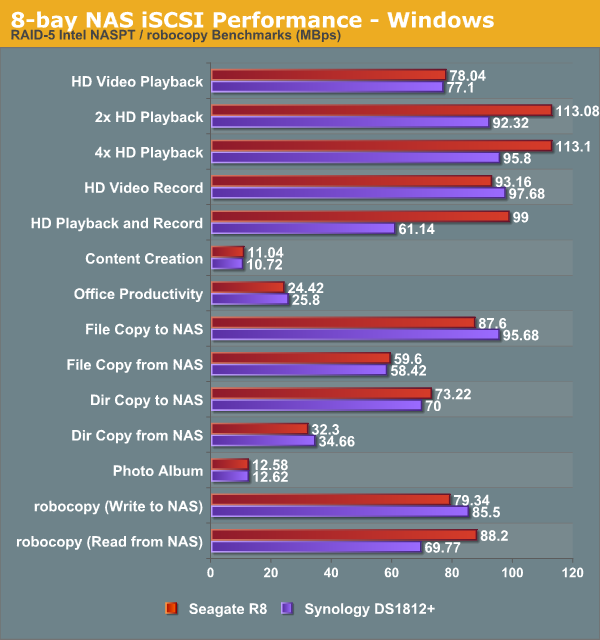Seagate Business Storage 8-Bay 32TB Rackmount NAS Review
by Ganesh T S on March 14, 2014 6:00 AM EST- Posted in
- NAS
- IT Computing
- Seagate
- Enterprise
Single Client Performance - CIFS and iSCSI on Windows
The single client CIFS performance of the Seagate Business Storage 8-Bay Rackmount was evaluated on the Windows platforms using Intel NASPT and our standard robocopy benchmark. This was run from one of the virtual machines in our NAS testbed. All data for the robocopy benchmark on the client side was put in a RAM disk (created using OSFMount) to ensure that the client's storage system shortcomings wouldn't affect the benchmark results. It must be noted that all the shares / iSCSI LUNs are created in a RAID-5 volume.

We created a 250 GB iSCSI target and mapped it on the Windows VM. The same benchmarks were run and the results are presented below.

It is interesting to note that the Atom D27xx-based Synology DS1812+ runs neck-to-neck with the Seagate R8, but the extra CPU grunt of the Celeron G1610T helps the Seagate unit march ahead in a number of benchmarks.
Encryption Support
The Seagate NAS unit, unfortunately, doesn't have native encryption support. Even though the Celeron G1610T doesn't support AES-NI, software-based enryption would have definitely yielded better results compared to what is obtained from Atom-based units. In any case, Seagate believes that using SEDs (Self-Encrypting Drives) for the disks would be a better option for customers with no impact at all to the NAS performance. Even though none of the SEDs are currently in the public compatibility list, Seagate says they do support them.
Under usual circumstances, we would not have liked the limiting of consumer options (since SEDs definitely cost a bit more compared to the non-encrypted versions). However, given that the HDD vendor and the NAS vendor are both the same for this product, it wouldn't be too much of a drawback. In essence, if the user / company is looking for a diskless enclosure, there are multiple options available with a better feature set. We believe the allure of these units stem from the fact that the disk and NAS vendor are one and the same, allowing for better support and lesser overhead for the IT department.










28 Comments
View All Comments
lorribot - Friday, March 14, 2014 - link
Sorry but the comment "Most users looking for a balance between performance and redundancy are going to choose RAID-5" is just plain stupid if you value your data at all. Look at anyone serious in enterprise storage and they will tell you Raid 6 is a must with SATA disks over 1TB. SATA is just pants when it comes to error detection and the likelyhood of one disk failling and then finding a second one fail with previously undetected errors when you try a rebuild is quite high.Rebuild times are often longer, I have seen 3TB drives stretch in to a third day.
So on an 8 disk system you are now looking at only 6 disks and you really want a hot spare so now you are down to just 5 disks and 20TB raw, formated this is going to be down to 19TB. Where has that 32TB storage system gone?
If you are doing SATA drive you need shelves of them, the more the merrier to make any kind of sense in the business world.
Penti - Saturday, March 15, 2014 - link
Audience?I don't quite get who's the target audience for this, surely an rack mount NAS must mean SMB/Enterprise. But can't really see this fit here. Lack of encryption is just one point there, but at this price it surely lacks in many other regards, it has no 10GbE, no raid-controller (rebuild time seems to be ridiculous). Software doesn't really seem up for small enterprises. What is this appliance supposed to be used against? iSCSI is it's main feature but what use is it at this speed? No proper remote management of hardware that costs around 2500 USD? That is using a 42 dollar processor? I don't get this product, what are you suppose to use it for?
ravib123 - Saturday, March 15, 2014 - link
We often use open filer or other linux based NAS/SAN platforms.Looking at this configuration I agree that most with an 8 disk array who are looking for maximum storage space would use RAID5, normally we use more disks and RAID10 for improved performance.
My curiosity is how CPU and Memory bound this thing must be, but I saw no mention of these being limiting factors. The performance is far below most configurations I've used with 8 disks in RAID5 (with a traditional RAID card).
Penti - Saturday, March 15, 2014 - link
The thing is that you get pretty decent hardware at 2000-2500 USD. Say a barebone Intel/Supermicro with IPMI/IPKVM (BMC), some Xeon-processor in the lower ends, AES-NI and all that and a case with hotswap bays and two PSU's. No problem running 10GbE, fiberchannel or 8 disks (you might need an add-on card or two). I would expect them to at least spend more then 500 for CPU, ram and board on appliances in this price range. It's not like the software and case itself is worth 2500 USD, plus whatever markup they have on their drives.SirGCal - Sunday, March 16, 2014 - link
Well, I used retired hardware and built a RAID6 (RAIDZ2) box with 8 drives, 2TB each, with nothing more then a case to hold them and a $41 internal SATA 4-port controller card. Downloaded Ubuntu, installed the ZFS packages, configured the array, and setup monitoring. Now I have a fully functional Linux rig with SSH, etc. and ~ 11,464,525,440 1K blocks. (roughly 11TB usable).I have another 23TB array usable using 4TB drives and an actual, very expensive, 6G, 8 port RAID card. The ZFS rig is right there in performance, even using slower (5400 RPM) drives.
So you can do it as cheap as you like and get more functionality then this box offers. Need multiple NIC, throw em in, need ECC, server boards are just as available. Need U-factor, easy enough. I agree with the others, I don't see the $2k+ justification in cost... Even if they had the 'self encrypting' versions for $400 each, that's $3200, leaving $1900 for the hardware... Eww...
alyarb - Thursday, March 20, 2014 - link
half-assed product. why is it only 30 inches deep? You could fit another row of disks if you use the entire depth of the rack. assuming you have a meter-deep rack of course, but who doesnt?I just want an empty chassis with a backplane for 3 rows of 4 disks. I want to supply the rest of the gear on my own.